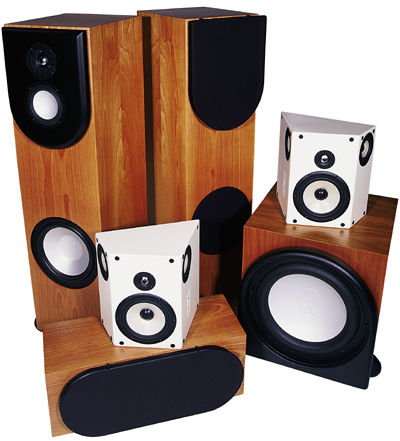Revel Performa F30 surround speaker system

Not long after that review was published, Revel showed prototypes of the Performas, a line of more affordable speakers to supplement the pricey Ultimas. First to appear was the floorstanding, full-range Performa F30, which, like all Revel speakers, was designed to serve in both 2-channel stereo and home-theater applications. The rest of the line took longer. The complete home-theater package was finally ready earlier this year. It was worth the wait.
Woofers and tweeters and mids, oh my!
While other Performa options are available (the M20 stand-mounted design is suitable for duty in any or all channels of a home-theater system), the system reviewed here consisted of a pair of F30s anchoring the left and right fronts, a C30 center-channel, a pair of S30 surrounds, and a single B15 subwoofer, all comprising a total of 19 drivers. While this figure is no indicator of quality, these particular drivers are products of some of the most advanced speaker R&D facilities on the planet.
All of the Performa midranges and woofers are built in-house by Revel, with the exception of those in the S30 surrounds. And the fiberglass cones in the surround's woofer and mid/tweeters are the only ones in the Performa line not made of some sort of metal alloy. Many of the woofers and midranges look like inverted domes, but are driven with conventional voice-coils attached to the rear center of their diaphragms.
Even the more conventional-looking woofers used in the F30s and B15 are anything but ordinary. The B15 subwoofer is particularly interesting. The subject of an intense development effort (it was the last speaker in the current Performa series to become available), the B15 has a 15-inch cone, a massive 3.7kg (8.1 lbs) magnet system, a 3-inch, 4-layer voice-coil, a heavy, cast-aluminum frame, and is driven by an amplifier rated at 1000W continuous-power output (1400W peak). According to Revel, it has a linear peak-to-peak excursion of 2.5 inches (3 inches maximum), and can output up to 126dB at 30Hz in a +6000-cubic-foot listening room—all from a box with a volume of less than 4 cubic feet.
Full-range F30
The stylish if slightly chunky F30 holds up the front left and right corners of the Revel sextet. Its inverted magnesium/aluminum alloy dome woofer and ported enclosure are rated to respond down to a usable 20Hz (-3dB at 30Hz). The midrange and tweeter are mounted on a low-diffraction baffle. Optional grilles are available, but I didn't use them. The rounded feet will also accept spikes. The connector panel provides dual sets of input terminals for biwiring or biamping, and a tweeter-level control with five positions: -1.0, -0.5, 0, +0.5, and +1.0dB.
Revel specifies the frequency response of the F-30 and the other speakers in this group in a number of ways, all of them impressively flat. The so-called “in-room" response is intended to closely correlate to sound quality; the other response specifications track the in-room rating to within 1dB.
Unlike some speaker engineers, Revel's team and their director of research and technology Kevin Voecks are firm believers in fast-slope crossover networks. All of the Performa models adhere to this philosophy, which is particularly important in drivers with rigid metal diaphragms. Such drivers operate as nearly perfect pistons up to a point, but when they start to break up, they do so abruptly—unlike softer materials, such as paper. I have no way of knowing, short of speaker surgery, how prone the Revel drivers themselves are to this phenomenon, but I do know that a crossover point well short of the breakup frequency, good crossover design, and fast crossover slopes can prevent this behavior from audibly degrading the sound.
Centered and Surrounded
The C30 center-channel speaker is a 3-way system, a configuration that, together with its relatively low (280Hz), steep-slope woofer/midrange crossover, minimizes some of the more obvious driver-interference problems typical of the more common 2-way, woofer-tweeter-woofer horizontal center-channel designs. It has a removable grille (which I did not use) and an optional stand (which I did). If you mount it atop a television, the feet can be moved to accommodate deep or shallow mounting surfaces. A placement-compensation control tweaks the response for top-of-monitor, flush-mounted, or stand-mounted placements. As on the F30, there is a five-position tweeter-level control. But, unlike the F30, the C30 has only a single set of input terminals and cannot be biamped or biwired.
- Log in or register to post comments




































































